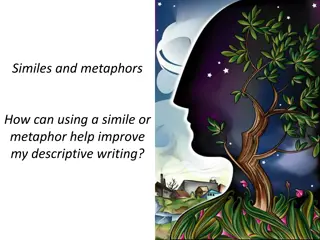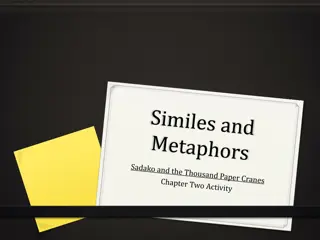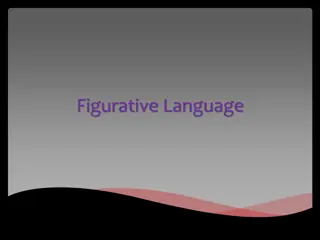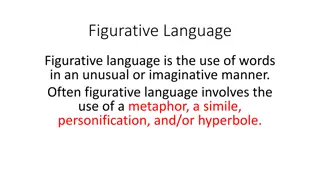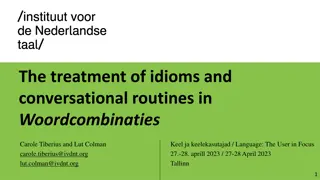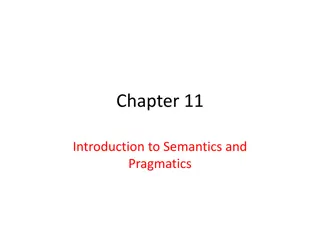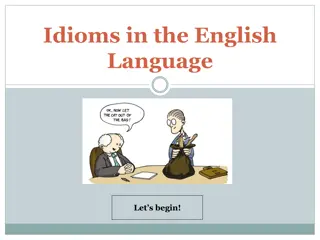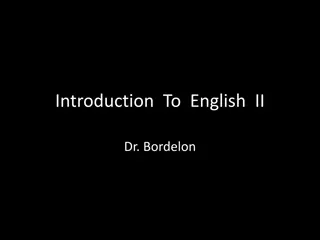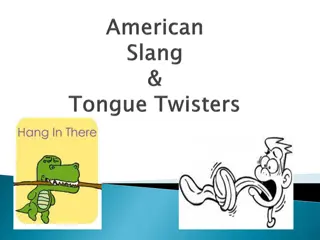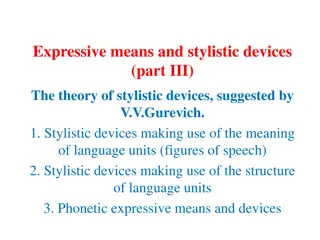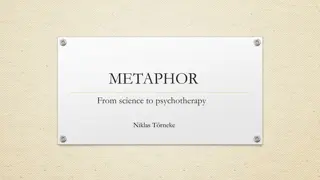Understanding Non-literal Meaning: Idioms, Metaphors, and Metonymy
The unpredictable world of non-literal meaning through idiomatic expressions, metaphors, and metonymy. Discover how these concepts shape language and thought.
Download Presentation

Please find below an Image/Link to download the presentation.
The content on the website is provided AS IS for your information and personal use only. It may not be sold, licensed, or shared on other websites without obtaining consent from the author. Download presentation by click this link. If you encounter any issues during the download, it is possible that the publisher has removed the file from their server.
E N D
Presentation Transcript
Understanding concepts Non-literal meaning Idiomatic expressions (idioms) Metaphors Metonymy
let the cat out of the bag take the bull by the horns Idiomatic expressions are multi-word phrases whose overall meanings are idiosyncratic and largely meanings that are not derivable by combing the literal senses of the individual words in each phrase according to the regular semantic rules of language. unpredictable, reflecting speaker (Hurford et al. 2007: 328)
1. The people let their hair down. Literal sense: people with long hair let their hair hang down from an up (constrained) position to fall around shoulders. Idiomatic sense: the people relaxed their inhibitions and behaved less carefully. Context for literal sense: perhaps the people were getting ready to wash their hair. Context for idiomatic sense: the people were in a relaxed mood at a party and behaved in a free and natural manner. (Hurford et al. 2007: 328)
2. We hauled them over the coals. Literal sense: we physically carried something over a pile of hot coals. Idiomatic sense: we disciplined some people. Context for literal sense: we had to carry something over actual hot coals, as in a burning building, in order to get it to safety. Context for idiomatic sense: we had to tell them that they were behaving badly. (Hurford et al. 2007: 329)
3. He put his foot in his mouth. Literal sense: he actually put one of his feet in his mouth. Idiomatic sense: he said something inappropriate. Context for literal sense: he could refer to a dog who is cleaning his feet by licking them. Context for idiomatic sense: a person is saying things that are inappropriate. (Hurford et al. 2007: 329)
My car is a lemon. Dr Jones is a butcher. Frank is a snake in the grass. Jane lives in a cottage at the foot of the mountain. Sam is a pig. Marie is sitting at the head of the table. (Hurford et al. 2007: 330- 331)
Metaphor: a device of the poetic imagination and the rhetorical flourish; a matter of extraordinary rather than ordinary language; a characteristic of language alone, a matter of words rather than thought or action; pervasive in everyday life, not just in language but in thought and action. Our ordinary conceptual system, in terms of which we both think and act, is fundamentally metaphorical in nature . (Lakoff and Johnson 1980: 3)
Our conceptual system is not something we are normally aware of. ! Language as an important source of evidence for what that system is like. ARGUMENT IS WAR Your claims are indefensible. He attacked every weak point in my argument. His criticisms were right on target. I demolished his argument. I've never won an argument with him. You disagree? Okay, shoot! If you use that strategy, he'll wipe you out. He shot down all of my arguments. (Lakoff and Johnson 1980: 4-5)
The essence of metaphor is understanding and experiencing one kind of thing in terms of another. (Lakoff and Johnson 2003: 5)
Metaphors conceptual (mental) operations reflected in human language that enable speakers to structure and construe abstract areas of knowledge and experience in more concrete experiential terms. Source domain a familiar area of knowledge Target domain- an area of knowledge that is less familiar (Hurford et al. 2007: 331)
Isolated instances of metaphorical concepts Idiosyncratic metaphorical expressions that stand alone and are not used systematically in our language or thought My car is a lemon. Dr Jones is a butcher. (Hurford et al. 2007: 331-332; Lakoff and Johnson 1980: 54)
Structural metaphors abstract metaphorical systems in which an entire (typically abstract) complex mental concept is structured in terms of some other (usually more concrete) concept. Structural metaphors allow us to use one highly structured and clearly delineated concept to structure another. (Hurford et al. 2007: 333)
TIME IS MONEY You're wasting my time. This gadget will save you hours. I don't have the time to give you. How do you spend your time these days? That flat tire cost me an hour. I've invested a lot of time in her. I don't have enough time to spare for that. You're running out of time. You need to budget your time. Put aside some time for ping pong. Is that worth your while?
TIME IS MONEY Do you have much time left? He's living on borrowed time. You don't use your time profitably. I lost a lot of time when I got sick. Thank you for your time. (Lakoff and Johnson 1980: 7-8)
IDEAS ARE MONEY Jane put in her two cents worth. John is rich in ideas. The book is a treasure trove of ideas. Mary has a wealth of new ideas. (Hurford et al. 2007: 334)
IDEAS ARE PEOPLE The theory of relativity gave birth to an enormous number of ideas in physics. He is the father of modern biology. Whose brainchild was that? Look at what his ideas have spawned? Those ideas died off in the Middle Ages. (Lakoff and Johnson 1980: 47)
IDEAS ARE PLANTS His ideas have finally come to fruition. That idea died on the vine. That s a budding theory. It will take years for that idea to come to full flower. He views chemistry as a mere offshoot of physics. (Lakoff and Johnson 1980: 47)
Orientational metaphors give concepts spatial orientation by associating an abstract knowledge area with some aspect of experiential knowledge grounded in how human beings understand their orientation in physical space, i.e. up vs down, front vs back, etc. HAPPY IS UP I'm feeling up. That boosted my spirits. My spirits rose. You're in high spirits. Thinking about her always gives me a lift. (Hurford et al. 2007: 335)
SAD IS DOWN I'm feeling down. I'm depressed. He's really low these days. I fell into a depression. My spirits sank. (Lakoff and Johnson 1980: 15)
CONSCIOUS IS UP Its eight o clock, time to wake up. HEALTH IS UP John is at the peak of health. HAVING CONTROL/FORCE IS UP Jane is on top of the situation. MORE IS UP The number of articles on semantics seem to keep going up.
HIGH STATUS IS UP The dean of the college occupies a lofty position in the university. GOOD IS UP Jack does high-quality work. VIRTUE IS UP That teacher always sets high standards. (Hurford et al. 2007: 335)
Ontological metaphors help structure our understanding of abstract concepts and experiences, such as events, activities, emotions, ideas, etc. in terms of our experience with actual physical objects and substances in the real world. (Hurford et al. 2007: 336)
INFLATION IS AN ENTITY Inflation is lowering our standard of living. Inflation is increasing every year. The negative aspects of inflation far outweigh the positive ones. Inflation is ruining our economy. We have to fight inflation or it will conquer us. (Hurford et al. 2007: 336; Lakoff and Johnson 1980: 27-28)
Referring My fear of insects is driving me crazy. That was a beautiful catch. We are working toward peace. Quantifying It will take a lot of patience to finish this book. There is so much hatred in the world. DuPont has a lot of political power in Delaware. (Lakoff and Johnson 1980: 26)
Identifying aspects The ugly side of his personality comes out under pressure. The brutality of war dehumanizes us all. I can t keep up with the pace of modern life. Identifying causes The pressure of his responsibilities caused his breakdown. He did it out of anger. Setting Goals and Motivating Actions He went to New York to seek fame and fortune. Here s what you have to do to insure financial security. (Lakoff and Johnson 1980: 27)
We live in a field by the lake. They travelled out of their home state. I m going to drive to Kansas next week. The mountains came into view. The city is now out of sight. (Hurford et al. 2007: 337)
They were many runners in the race. Jack got into the car racing as a young man. John and Mary are in love. The girl fell into a deep depression. (Hurford et al. 2007: 337)
Personification is a particular subtype of ontological metaphor in which an abstract entity is construed as though it were a physical object which is then further specified as being a person. That theory explains everything you need to know about metaphor. I think that life has cheated me out of any hope of happiness. (Hurford et al. 2007: 338)
Metonymy is a kind of non-literal language in which one entity is used to refer to another entity that is associated with it in some way. In other words, metonymic concepts allow us to conceptualize one thing by means of its relation to something else (Lakoff and Johnson 1980: 39). The ham sandwich in the next booth is waiting for his bill. (Hurford et al. 2007: 338)
1. We enjoy watching Hitchcock more than Spielberg. 2. The Times asked a pertinent question at the news conference. 3. The White House refused to answer the question. (Hurford et al. 2007: 338)
THE PART FOR THE WHOLE The automobile is clogging our highways. (= the collection of automobiles) We need a couple of strong bodies for our team. (= strong people) There are a lot of good heads in the university. (= intelligent people) I've got a new set of wheels. (= car, motorcycle. etc.) We need some new blood in the organization. (= new people) THE FACE FOR THE PERSON She s just another pretty face.
PRODUCER FOR PRODUCT I'll have a Lowenbrau. He bought a Ford. He's got a Picasso in his den. I hate to read Heidegger. OBJECT USED FOR USER The sax has the flu today. The BLT is a lousy tipper.
CONTROLLER FOR CONTROLLED Nixon bombed Hanoi. Ozawa gave a terrible concert last night. Napoleon lost at Waterloo. A Mercedes rear-ended me. INSTITUTION FOR PEOPLE RESPONSIBLE Exxon has raised its prices again. You'll never get the university to agree to that. The Army wants to reinstitute the draft. The Senate thinks abortion is immoral. I don't approve of the government's actions.
THE PLACE FOR THE INSTITUTION The White House isn't saying anything. Washington is insensitive to the needs of the people. The Kremlin threatened to boycott the next round of SALT talks. Paris is introducing longer skirts this season. Hollywood isn't what it used to be. Wall Street is in a panic.
THE PLACE FOR THE EVENT Let's not let Thailand become another Vietnam. Remember the Alamo. Pearl Harbor still has an effect on our foreign policy. Watergate changed our politics. It's been Grand Central Station here all day. (Lakoff and Johnson 2003: 35- 40)
Hurford, J. R. et al. (2007). Semantics: A Coursebook. Cambridge: Cambridge University Press. Knowles, M. and R. Moon. (2006). Introducing Metaphor. London and New York: Routledge. Lakoff, J. and M. Johnson. (1980). Metaphors we live by. London: The University of Chicago Press.


